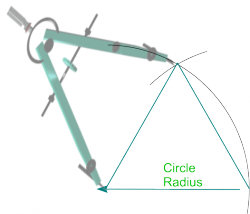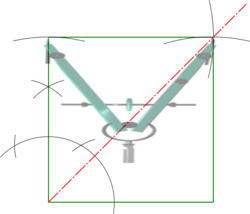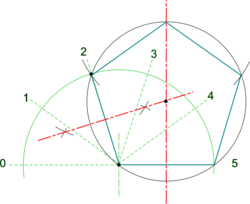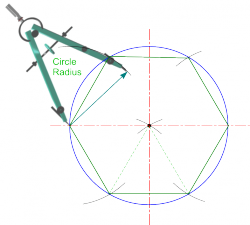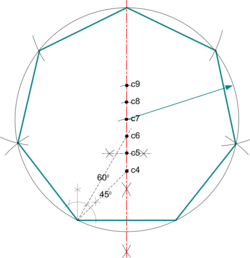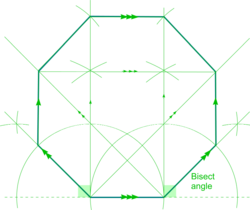Polygons: Difference between revisions
From DT Online
(Creat Polygons) |
(Added septagon) |
||
| Line 34: | Line 34: | ||
| <span style="color:#B00000"> | | <span style="color:#B00000"> | ||
* Draw a line of length equal to the length of side required and construct its perpendicular bisector - (see '''[[Basic Constructions]]'''). | * Draw a line of length equal to the length of side required and construct its perpendicular bisector - (see '''[[Basic Constructions]]'''). | ||
---- | |||
<span style="color: green">'''Note:''' | |||
Polygons with odd numbered sides have an apex at top centre and this can be used for greater accuracy as an alternatve starting point, or as check, when stepping off sides round the circle . | |||
</span> | |||
---- | |||
</span> | </span> | ||
| [[File: | | [[File:CompassPentagon2.png|250px|right]] | ||
|- | |- | ||
| '''Hexagon''' | | '''Hexagon''' | ||
| <span style="color:#B00000"> | | <span style="color:#B00000"> | ||
* ### </span> | * Draw a line of length equal to the length of side required and construct an equilateral triangle on this as the base ''(see above)'' | ||
* Set radius to length of side and draw the circumscribing circle for the hexagon from the top apex of the triangle. | |||
* With same radius set, step off sides around the circle as shown. | |||
---- | |||
<span style="color: green">'''Note:''' | |||
### | |||
</span> | |||
---- | |||
</span> | |||
| [[File:CompassHex.png|250px|right]] | | [[File:CompassHex.png|250px|right]] | ||
|- | |||
| '''Septagon''' | |||
| <span style="color:#B00000"> | |||
* Draw a line of length equal to the length of side required and construct its perpendicular bisector - (see '''[[Basic Constructions]]'''). | |||
* From one end of the base line construct 45<sup>0</sup> and 60<sup>0</sup> angles. | |||
* Where these to angles cross the vertical centre line would mark the centres of circumscribing circles for squares and hexagons respectively | |||
* Bisect between these two centres. | |||
---- | |||
<span style="color: green">'''Note:''' | |||
This circle would circumscribe a pentagon and provides an alternative construction. | |||
</span> | |||
---- | |||
* Set radius to half the distance between c4 and c6 and step off above c6 to create c7 - the centre of a circle which circumscribes a Septagon ''(or Heptagon)'' | |||
* Set radius to the length of side and step off round the circle. | |||
</span> | |||
| [[File:CompassSeptagon.png|250px|right]] | |||
|- | |- | ||
| '''Octagon''' | | '''Octagon''' | ||
Revision as of 17:04, 25 February 2015
Drawing regular Polygons is now most easily accomplished using modern drafting aids and Computer Aided Design tools. But there are occasions when it is useful to have an understanding of some basic constructions using just rule and compasses (or pegs and pieces of string). Examples might include large scale work for stage sets or carnival floats, or on-site work for buildings, playgrounds, sports fields and gardens.
The following examples are limited to constructions of regular polygons. Irregular polygon construction may be achieved using a process of triangulation, vectors, coordinates or plotting points on a matrix for example. Some other polygons (e.g. Cyclic Quadlitateral) have particular properties which can be helpful to know when constructing them.
See also the YouTube video All the possible polygons!. This shows how all regular polygons can be constructed using classical geometry techniques
Note: Some constructions on the YouTube video may be different to those described below - there are several methods of construction possible for most regular polygons.
| Equilateral Triangle |
|
|
| Square |
|
|
| Pentagon |
Note: Polygons with odd numbered sides have an apex at top centre and this can be used for greater accuracy as an alternatve starting point, or as check, when stepping off sides round the circle .
|
|
| Hexagon |
Note:
|
|
| Septagon |
Note: This circle would circumscribe a pentagon and provides an alternative construction.
|
|
| Octagon |
|
